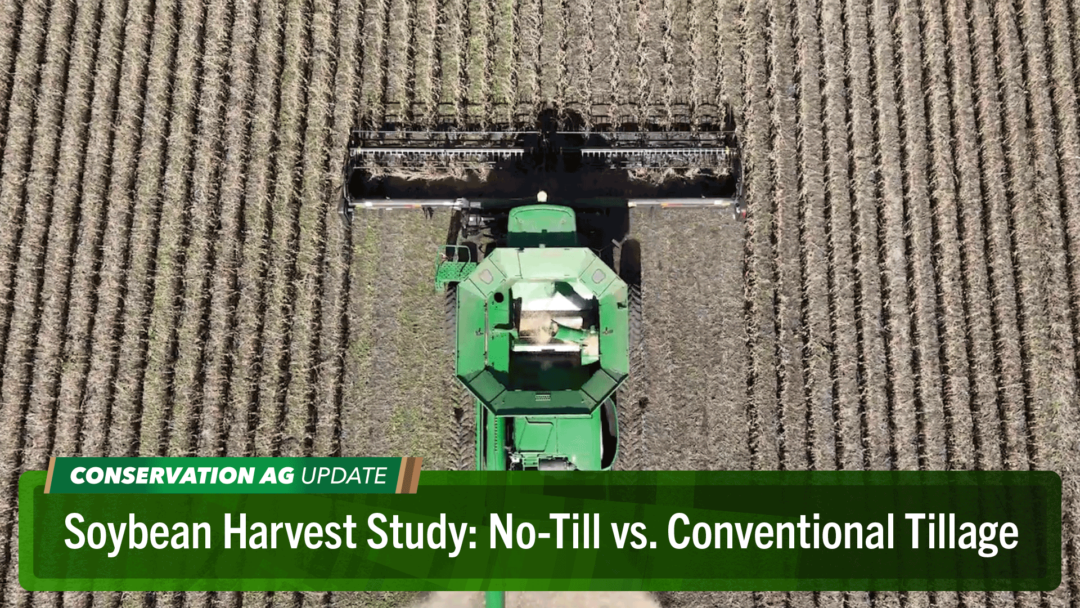On this episode of Conservation Ag Update, brought to you by CultivAce, we break down harvest results from a couple studies in the Corn Belt — no-till vs. conventional tillage soybeans in Indiana, and a nutrient stratification study in Illinois.
Plus, in the Cover Crop Connection segment, assistant editor Mackane Vogel shares a new piece of equipment that’s piquing the interest of cover croppers.
Later in the episode, Lowell, Ind., native Dan Sutton talks about some key changes he made to his Kinze planter that took his 1,300-acre operation to the next level. Raven gives us an up-close look at its new cart automation technology in the Ahead of the Curve segment, and a Pioneer agronomist shares photos and results from the “coolest fungicide trial ever.”
This episode of Conservation Ag Update is brought to you by CultivAce.
CultivAce is a West Coast manufacturer and distributor of a comprehensive line of foliar and starter fertilizers. CultivAce offers innovative solutions that drive agricultural crop yields and cultivate profitableoutcomes.
With a relentless focus on delivering the highest quality foliar and starter fertilizers, we are committed to empowering growers with the tools they need to achieve remarkable results. CultivAce is built on two fundamental principles: products must be the highest quality, and they must make the grower money. If a product doesn’t meet these standards, CultivAce doesn’t manufacture it.
For more information go to CultivAcegrowth.com.
TRANSCRIPT
Jump to a section or scroll for the full episode...
- No-Till Outyields Conventional in Indiana Soybean Study
- No-Till Legend Shares New Data from P & K Stratification Study
- Montag’s Cover Crop+ — Designed for Smaller Seeds
- No-Tiller Improves Results with Closing Wheel Adjustments
- Ahead of the Curve: Raven Cart Automation
- Photo of the Week: “Coolest Fungicide Trial Ever”
No-Till Outyields Conventional in Indiana Soybean Study
Let’s highlight one in Starke County, Ind., comparing yield differences between no-till and conventional soybeans. The study was conducted by the Starke County Soil and Water Conservation District in conjunction with Purdue extension. And the winner is…no-till at 53.9 bushels per acre, 2.3 bushels higher than the conventional plot. Purdue University’s Phil Woolery and Starke County supervisor Lee Naigie break down the results.
“The better yields are on the poorer grounds. So, we start there to the east where the ground is a little bit better, and those were the poorest yield results. And it uniformly works its way towards the west where the ground is higher and dryer, and the yields are getting better and better.
“When I was out there doing scouting, we had a lot more white mold problems. I think disease had an effect on yields there.”
“Yea, I think we’re clearly seeing a white mold issue this year. The dryland stuff is going to probably yield better than the irrigated stuff.”
“This is the 5th year of no-till. Up until this year, I was pretty convinced that we were better off with tillage. But this is the first year now where the no-till strips have clearly outyielded the conventional tillage strips.”
No-Till Legend Shares New Data from P & K Stratification Study
Moving on to another study in Alpha, Ill. No-Till Legend Marion Calmer checks in with new data from his soil stratification study.
For the second year in a row, the plot with phosphorous (P) and potassium (K) plowed into the root zone came out on top, with 222 bushels per acre, compared to 202 bushels per acre in the broadcasted plot and 173 bushels per acre in the plot with no P and K.
“The yield advantage to plowing it down or putting it in the root zone is 20 bushels per acre. So, we’ve got a SoilWarrior that we’re going to use this fall. We’re out there, and we’re in between old corn stalk rows. Our objective here is to strip-till ahead of 30-inch beans for next year, and then also we’ll be in the bean stubble, and we’ll be strip-tilling and applying P, K and nitrogen in the trench. You can see how it’s loosened up the soil. It’s going to be blacker, warmer, drier and less compacted for next year.”
Calmer will dive deeper into his nutrient stratification research at the 2024 National No-Tillage Conference in Indianapolis. Register at NoTillConference.com.
Montag’s Cover Crop+ — Designed for Smaller Seeds
Mackane Vogel here for this week’s cover crop connection. Roger Murdock, director of sales & marketing for Montag Manufacturing, took some time to show me one of the company’s newest cover crop innovations. Check out this clip of Murdock talking about the key features of Montag’s Cover Crop Plus and what makes it ideal for planting cover crops of all different species, especially those with smaller seeds.
“Montag realized that there was a need for a unit that is specifically designed for cover crops. So our cover crop plus unit takes a machine that we had already designed for doing cover crops and nutrients, but with our cover crop plus, in this video here, you can see that the auger is designed to handle the very small seeds. And crops like CoverCressTM which is an oilseed that is as much as 500,000 seeds to the pound — so very tiny seeds — so we needed to redesign our delivery system to accommodate those seeds. So now, the cover crop plus can be utilized on tillage equipment, it can be used on the Harvest Seeder, which is a unit that attaches to the combine so now as I am combining, I can put my cover crop down. We also have — if you really need a lot of cover crop put down at one time — you can take off the Hagie tank on the big sprayers, put the fortifier on so you can deliver cover crops over 120 foot boom. And now, recently we just added it to the Hagie detasseler so now as they’re detasseling or doing destruction with the raising of seed corn, you can put cover crops down also.”
Always exciting to see farm equipment that is being made specifically with cover croppers in mind.
No-Tiller Improves Results with Closing Wheel Adjustments
Lowell, Ind., native Dan Sutton has been planting green into cereal rye for almost 10 years and no-tilling for nearly 25 years. In today’s Farmer Feature, Sutton talks about some key changes he made to his Kinze planter that took his 1,300-acre operation to the next level.
“Most of you are familiar with the traditional rubber closing wheel that comes on just about every planter that’s made today. This would’ve been the original wheel on this Kinze. What we found, though, is when we tried it in our no-till cover crop situations, we couldn’t get enough down pressure, and it didn’t close that seed trench, especially due to cover crops. So, we experimented. The first season we put Pro-Stitch wheels across the back of the planter, and on the front, we ran the rubber wheels, because we wanted to compare the two. That’s how we found the rubber ones couldn’t do as good of a job as the Pro-Stitch wheels.”
“Then we took it one step further, we wanted to take off the rubber ones and put on something else. What do I want to put on? So, both Copperhead and Yetter make similar poly spiked closing wheels. The Copperheads have a straight tooth. The Yetter ones are mounted on there at a 45-degree angle. They essentially do the same job; we couldn’t see any difference between the Copperhead with the straight tooth and the Yetter with the angled tooth. They are more aggressive than the Pro-Stitch wheel. So, in a cover crop, no-till situation, this is our go-to wheel.”
Sutton says he runs the Pro-Stitch wheels one notch more aggressive on the down pressure than the Yetter or Copperheads.
Ahead of the Curve: Raven Cart Automation
We like to fill you in on the latest cutting-edge technology here on Conservation Ag Update. We call it Ahead of the Curve. And today we’re talking about Raven Cart Automation, which is designed to make harvest operations more efficient. Let’s hop in the cab with autonomy specialist Adam Lowe to see how it works.
“We’re going to slow down. It’s going to center, it’s going to say sync, and now he can move us to different positions to where he needs to fill the grain cart. When we get towards the end, he’s going to send us an unload request, send us this combine request here, just a notification to let us know ‘I’m done with you’. We hit the green check to make it go away, and we can disengage the system.”
“The biggest efficiency aspect that I see is it puts unskilled labor in the cab. It takes all the precision out of the hands of the tractor operator and puts it into our system to where we don’t have to communicate with them as much. We sync up to it, now they can move us all around. There’s no communication back and forth, whether it’s hand signals, over a cb radio, whatever it may be. It puts all the precision into our system so we’re not spilling as much grain or crop.”
Photo of the Week: “Coolest Fungicide Trial Ever”
Wrapping things up with our Photo of the Week. This one comes to us from Pioneer agronomist Troy Deutmeyer.
He posted this on X, formerly known as Twitter. Troy calls it the coolest fungicide trial ever, conducted by Travis McCormick at Ag Solutions in Coulter, Iowa.
He used John Deere ExactApply precision spraying technology to spell “Does it Pay” with Miravis Neo fungicide. Troy says it does pay, as you see in the results here.
The fields that were treated with the fungicide outyielded the untreated fields by an average of 34.2 bushels per acre. He says there was very little disease in the field, so it was all about plant health in this case.
Have an interesting photo or video from your farm? Or a story you’d like us to feature on the broadcast? Send me an email at Nnewman@lesspub.com.
And that will wrap things up this edition of Conservation Ag Update. Until next time, for more stories visit no-tillfarmer.com, striptillfarmer.com and covercropstrategies.com. Thanks for stopping by. Have a great day!








